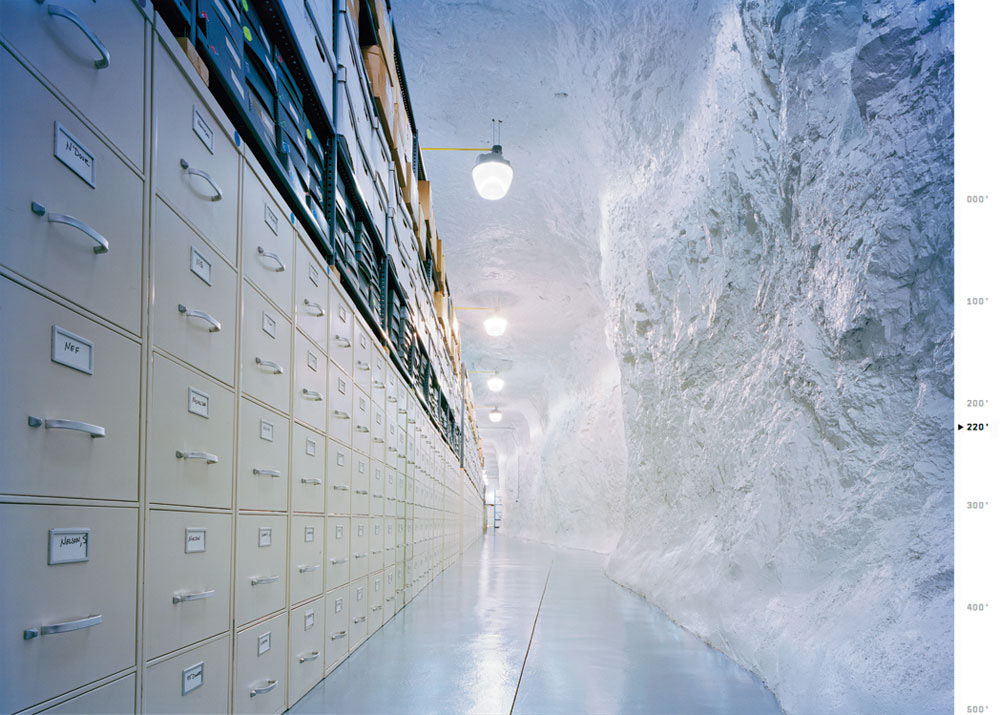Previously known as a limestone mine in Pennsylvania, is now known as a home to 15 million images, including some of the worlds most iconic Photographs, all stored 220 feet below ground.
(Photo: Christoph Morlinghaus)
An abundance of photographic history is all stored in one place, located 220 feet underground in former limestone mine in Iron Mountain, PA. The facility is home to 15 million original negatives and prints of some of the world’s most iconic photos, dating back to the civil war. Many of the images have been scanned, which have become available digitally online, but as the video footage shows below, that some of the originals of the most iconic images, have been severely damaged over the years. Corbis, Chief Historian and Archivist, Ken Johnston, revels that around 99% of the images are credited to anonymous photographers. Johnston values what some many consider the outtakes, pointing to an image from the Vietnam War of children running from Napalm that was taken from a different angle, than the Pulitzer-winning image that reveals a crowd of calm photojournalists. As he points out, in our digital age, there is nothing that can match the original negatives, showing what really happened, where as today the photographer can just delete the photograph.
Bill Gates caught Flak from photographic historians and researchers in 1995, when he moved his vast Corbis photographic collection from New York City to a refrigerated cave 220 feet beneath the ground in a rural Pennsylvania mountain, near Butler. The move took place between summer 2001 and March 2002, which required 19 refrigerated trucks. The photographs might be preserved, critics said, but nobody would ever again have easy access to them. Most of those skeptics now realise that Gates — Corbis, which he founded in 1989 — did the right thing. He has preserved an irreplaceable photographic history and has kept it accessible. The Film Preservation Facility, which accumulates to the length of two football fields, is an underworld of photographic history, you are immediately stuck by the orderly rows, hundreds of filing cabinets and crates containing old negatives, glass plates, and prints.
Within Iron Mountain UPI’s (United Photographers International) vast collection is stored, the weathered and well-worn New York bureau daily logbooks, and the thousands of original 4×5 envelopes used for negative files well after UPI’s executive editor Harold Blumenfeld switched UPI photographers to 35mm in the 1960s (the 35mm film was cut into three-frame strips so it could be filed in 4×5 envelopes). UPI’s photographs had been produced for speed, not archiving. In the rush to transmit pictures to UPI clients, black and white film and prints were rarely fixed long enough to dissolve out all the residual silver. During the 1920s – 1980s acetate was the most common film base which meant, in time, deteriorates. The deterioration occurs even more quickly when film is improperly fixed. It is also believed that degrading acetate films are contagious and can hasten the decay of other films stored in the same area. Bureaus and photographers would ship both film and prints to New York, where there was no motive or staff to re-fix the film and prints. The 4×5 inch Kraft file envelopes were made of acidic paper and held together with animal glues. Prints were filed by subject in ordinary file cabinets and kept at room temperature with no humidity control. In short, UPI was doing just about everything wrong in the way it stored and handled prints and negatives, as early as the 1970s a strong hint of vinegar in the air warned of prints and film going bad.
In 1995 Bill Gates’ Corbis bought it all — UPI’s 11.5 million images and the 5 million pictures Bettmann (who tried to restore the UPI collection) had accumulated since 1933 — for an “undisclosed” price, reported by Newsweek to be $6 million. Corbis has since added several other large photographic collections and more than a dozen smaller ones. Corbis kept its UPI acquisition in a New York office but knew that the clock was ticking on a collection that had been deteriorating for years from heat, humidity, and less-than-gentle care and handling. Corbis’s researchers (many of them longtime Bettmann employees) discovered that only about 100,000 of the UPI/Bettmann collection’s 11 million original images had never been looked at by a client, and of that number, only about 75,000 had ever been licensed. As it sought a long-term solution to preserving its collection, Corbis did a heroic edit of the vast archive, trying to learn what had sold well and what was most likely to sell in the future. Corbis worked with Henry Wilhelm, an expert on the preservation of traditional, digital colour photographs, motion pictures and the long-term preservation of photographic materials in subzero cold storage. Wilhelm wrote a 21-page recommendation for rescue options, and when Corbis decided that subzero storage was the way to go, Wilhelm oversaw the vault’s construction at Iron Mountain. Keeping the collection at 4 degrees below zero fahrenheit would halt deterioration, leaving the photographs intact and usable for at least another five thousand years. He compared the effect to that of a woolly mammoth whose perfectly preserved carcass was found in Siberian permafrost in 1999. The mammoth slipped into an ice crevice and froze before decay could begin, to be discovered 20,000 years later with tissues intact.“It’s a real demonstration of how cold storage works. The lessons for film materials are clear. The gelatin layer of film is made from connective tissue of cows, essentially the same as the woolly mammoth. There’s just no doubt that this will work for film.”








